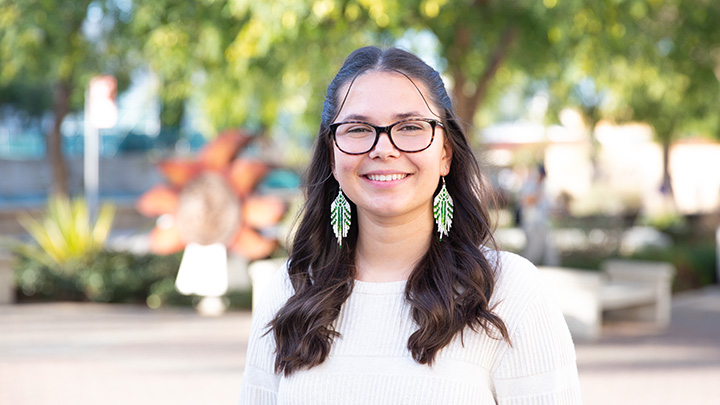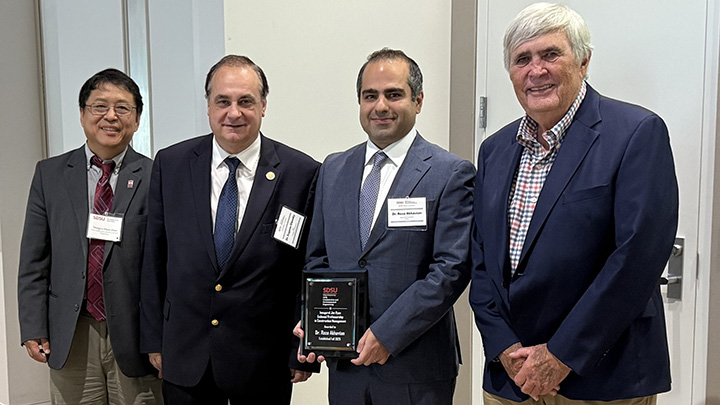Seeking Soil-Based Solutions
SDSU biologists received new grants to unravel mysteries of microbes around the world

Rising temperatures and air pollution from increasingly prevalent wildfires are some of the most familiar signs of climate change, but the dirt beneath our feet — and the microorganisms that live in it — might hold the key to today’s most pressing problems of climate change and infectious diseases.
Xiaofeng Xu, a San Diego State University global change ecologist, is building models of how soil microbes produce and absorb greenhouse gases like carbon dioxide and methane.
Xu recently earned a $640,000 CAREER award from the National Science Foundation to synthesize data on bacteria, fungi, and viruses in soils around the world, and further enhance scientists’ ability to predict the role of microbes in climate change.
“Our team will develop a first-ever data system for the community to contribute data on soil microbes around the world,” Xu said. “We will use these data to develop models to test existing and new theories about how microbes interact with each other and respond to changes in their environment.”
Temperature, moisture and the presence or absence of plants are just a handful of the factors that affect microbes’ ability to capture or release greenhouse gases. And each of these variables will change differently depending on whether you’re looking at a patch of dirt in San Diego or Alaska.
As humans, we adapt to our changing environment; microbes are similar but how they adapt hasn’t been well-represented, Xu explained.
Digging up data
Most of the data that scientists currently have has been collected from small, disparate sites in North America, Europe, and to a lesser extent Asia. Xu plans to extrapolate from existing data to understand soil microbes’ role in climate change across the whole globe in the past 100 years and in the next 100 years.
Integrating information about the various species of microbes and how much carbon and nitrogen they are producing in different areas will help explain the mechanisms underlying the biological, geological, and physical phenomena of climate change.
Building on his previous models and earlier work about how seasons affect microbe activity, Xu’s research can lead to improvements in soil management practices in forests, farms, and other ecosystems to sequester more carbon in the ground instead of in the atmosphere.
“For over twenty years, I’ve been fascinated by the question of how these tiny microbes play a big role in shaping the whole world,” Xu said. “I appreciate the recognition by NSF and the community for my and my lab’s efforts to develop this research program.”
Wormy wonders
Another SDSU biology assistant professor, Robert Luallen, received his own $1 million NSF CAREER award to examine microorganisms he and his collaborators originally found in rotted crabapples laying in the dirt of a French orchard.
His lab investigates how bacteria invade their host cells, primarily using small transparent worms called nematodes. These worms allow for easy and rapid visualization of biological processes, such as the processes that bacteria use to infect animals and the host response to these bacterial pathogens.
“I got into researching worms because I really like basic research. Things that are technically really difficult in other systems to answer can be answered in worms,” Luallen said.
Many of the genes in these worms are analogous to genes in larger, more complex animals, including humans. Therefore, figuring out how bacteria infect these worms can help scientists better understand how similar bacteria might infect humans or cows.
Earlier this year, Luallen and his team published their discovery of a new species of bacteria that transforms into long filaments to spread from cell to cell within a host. With this new grant, they can investigate whether other bacterial species rely on the same spreading mechanism, and, if so, whether it is controlled by similar genes.
“Answering such questions could provide novel strategies for treating bacterial infections and controlling environmental bacteria,” Luallen said.
After months of waiting on pins and needles for an official announcement about his award, Luallen was relieved to share the good news, “I’m really excited. It means so much for me and my students to receive this award for fundamental cell biology.”
Pay(dirt) it forward
“These awards to our young faculty not only acknowledge their scientific and technical skills, but also their talent and passion to train the next generation of scientists,” said Jeff Roberts, dean of SDSU’s College of Sciences. “They are continuing a history of research and mentorship excellence in the Department of Biology.”
Xu’s NSF CAREER grant, in partnership with the Maximizing Access to Research Careers program, will support training SDSU students how to integrate numerical modeling, machine learning and statistics into ecology research projects.
In addition to providing stipends for graduate assistants, Luallen’s grant will fund several undergraduate research assistants to learn about hunting for and studying worm pathogens. They will then pass on this knowledge to local high school students by teaching interactive science lessons.
Both initiatives aim to bolster undergraduates’ confidence in their skills and make scientific research more widely accessible, especially to first-generation and low-income students.



